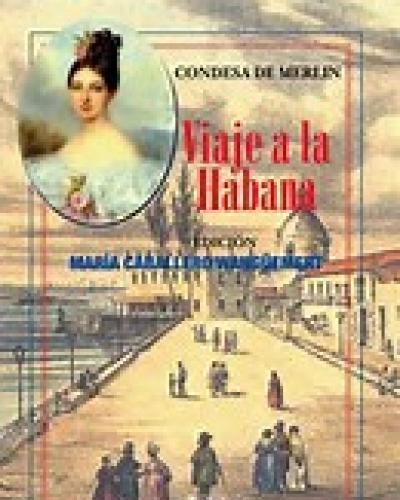María de las Mercedes Santa Cruz y Montalvo, the Countess of Merlin (1789-1852) was born in Cuba, Since twelve years of age she lived first in Spain and then in France. It was not until 1840 that she returned to visit her homeland. Many of the impressions and experiences are reflected in her book La Havane (1844), written in French and which consists of thirty-six letters. Its Spanish translation, Viaje a La Habana (1844), includes only ten letters because Spanish political censorship explicitly omitted the ones that dealt candidly with the subject of slavery and openly criticized the metropolis.
In Viaje a La Habana in a letter to French authoress George Sand, dated July 1st The Countess Merlin described the typical aristocratic Cuban woman in 1840’s Havana:
Her movements, stamped with a certain voluptuous languor, her slow and lazy steps, her sweet and lilting speech sometimes contrast with the vivacity of her features and the sudden flames escaping from her eyes, the look of which has no equal. She never sees the sun, besides the inconvenience of the heat, aristocratic pride forbids her to mix with the world of the streets. She goes out only at sunset, and never on foot.
At dusk, the graceful sylph, dressed in white, her head adorned with nature’s flowers, climbs into the horse-drawn carriage or volanta and leaves home to visit the merchants. She never dismounts from the carriage, but alternatively makes them bring the whole store to her footboard, after which she goes to have some fresh air. If she has to go to the countryside: she moves serenely from the armchair or butaca to the volanta, facing the hottest sun in white clothes, bareheaded and without an umbrella - like a hero in the breach braving the cannon.
Countess Merlin recorded her observations of the Cuban woman’s love of dancing
By way of contrast, Havana women like dancing, with passion; they spend the entire night on their feet, excited, whirling, crazy and glittering, until they fall down spent.
A habanera never uses her dancing dress twice, even if it is the most luxurious and had been shipped at great expense from Paris; a young woman prefers not to go to a dance than to appear in it wearing the same dress for the second time. In the theater, women are always well dressed and often wear diamonds, as well as at dances: they have them in large quantity, always mounted in Paris.
Countess Merlin ended her letter to George Sand with a description of the aristocratic Habanera in old age:
It is a sweet thing to see the respect that surrounds the mothers of the family here when they reach old age! Powerful trunk of numerous descendants, the grandmother is the object of all attentions, of the veneration of all. Parties, wedding receptions take place in her home; she can be seen presiding over the big table, dressed simply, her hair white, which she has never tried to hide, gathered and braided. All the dedication, all the pampering are for her or come from her. And when the day arrives in which this patriarchal life should come to an end, she dies gently, without sorrow and without remorse, in the same way she lived.


